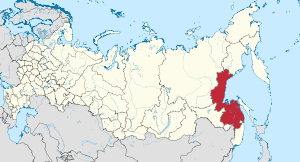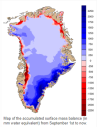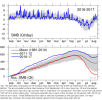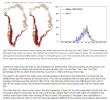A record-setting heat wave is poised to unleash its full power
Friday and Saturday with temperatures soaring above 110 degrees in some locations — conditions that will likely result in two of the hottest days in at least a decade.
The scorching conditions expected this weekend have already
resulted in the cancellation of some events and caused high school officials to cancel or push back start times of football games, and prompted at least one school district, Orinda Union, to shorten its school day Friday.
The scorching conditions expected Friday and Saturday could tie or break
Livermore’s all-time record high of 115 degrees, set in 1950. Livermore — one of the Bay Area’s hottest spots — has a forecast high Friday of 114, with 115 expected Saturday.
Other expected highs Friday include Concord 112, Gilroy 110, Morgan Hill 109, San Jose (airport) 103, Redwood City 103, Oakland 99 and San Francisco 96.
Gilroy and Livermore have not recorded a 110-plus degree day since 2006.
While the oppressive conditions will be mostly felt inland, folks living closer to the Bay won’t escape the heat.
“We want to stress most locations around the Bay that typically stay cooler will approach the 100-degree mark, places like Hayward, Fremont and Redwood City,”
said Roger Gass, a meteorologist with the weather service. “Typically they see the cooling effects of being close to the Bay. The only relief we see from this event is right along the coastside.”
Even then, Gass said,
temperatures along the coast could soar in the 90s.
The California Independent System Operator Corporation issued a voluntary Flex Alert for Friday that calls for sparing use of high-consumption appliances like A/C units and washing machines between 1 p.m. and 10 p.m.
For those who do use air-conditioning, the agency suggests that thermostats should be set at 78 degrees or higher. ISO manages about 80 percent of electricity use in the state.
Temperatures started to climb Thursday, as the mercury hit a new Aug. 31 record in San Rafael of 99 degrees, topping 93 degrees on Aug. 31, 1998, according to the weather service. San Jose was 95 degrees, matching an Aug. 31 record in 1943. It was 90 in Oakland and 86 in San Francisco, both approaching records for the date that have stood more than half a century.
Adding to the scorching temperatures, smoke from wildfires in Northern California and Oregon has arrived in the East Bay and Peninsula, reducing visibility in some places and increasing concentrations of soot.
“The smoke has been moving toward us for several days and now it’s here,”
said Kristine Roselius, a spokeswoman for the Bay Area Air Quality Management District.
Oakland has a “red flag” fire danger warning in effect until at least 8 a.m. Saturday, according to acting Oakland Batallion Fire Chief Frank Tijiboy. He said there will be patrols in the Oakland hills and in what is considered the “mutual threat zone,” from the San Leandro border north to the Berkeley border.
The overall fire danger in the East Bay isn’t made significantly greater by the weekend’s stifling heat, said Ryan Bain, a spokesman for the Contra Costa County Fire Protection District —
the area is already a tinder box.
“The low humidity is what kills us, and what makes the fire danger so high,”
Bain said Friday. Both Oakland and Contra Costa County are on high levels of dispatch, with even a report of smoke drawing responses of at least six (Oakland) or five (Contra Costa) engine trucks and crews.
The double whammy of smoke and smog has led the district to issue a Spare the Air alert for what they predict will be unhealthy smog levels on Friday for the Bay Area. And it has prompted cancellation of events, including the Livermore Winegrowers Harvest Festival Harvest, and changed hours of other public and sporting events, and school hours.
The 36th annual Livermore wine festival had been expected to draw 1,000 or more people Sunday afternoon to an outdoor sports field at Las Positas College, but organizers pulled the plug out of concern for the health of visitors and staff.
“Our first priority is the health and welfare of our community,” said Chris Chandler, executive director of the Livermore Valley Winegrowers Association. “The excessive heat forecasted by local and national weather services is a safety risk we are not willing to take.”
Festival tickets will be refunded and the event will not be rescheduled this year, the association said.
Orinda Union School District parents were told Thursday that classes would get out early Friday because of the heat. Four elementary schools were to end their day at 1:55 p.m., and Orinda Intermediate School at 1:05 p.m.
For many, Thursday’s temperatures were smothering.
In Gilroy, where it soared to 98 degrees on Thursday, solar panel installers with Poco Solar Energy in Santa Clara knew to start work extra early, before the roofs got so hot and soft they couldn’t walk on them safely, said Jonathan Gonzalez, the company’s customer relations manager.
Over at the Beaver Creek Smokehouse in Martinez, co-owner Robert Zavatero, 59, posted a note early Thursday afternoon on the restaurant’s door alerting customers that the extreme heat would temporarily cut hours of operation because “our equipment will not work properly when overheated.’’
Meanwhile, state officials are asking all California residents to conserve their power use during peak afternoon and evening hours Friday as they look to keep the state’s power grid humming along over the Labor Day weekend.
Garcia said the heat wave is occurring because of a large area of
high pressure from the Pacific Ocean is moving over the region and heading to the Nevada/Utah area. For now, he said, it appears the East Bay is being affected most by the high pressure, and that is the reason Livermore and Walnut Creek are posting triple digit numbers.
“And so we are seeing this area of high pressure act like a heat dome,’’
Garcia said, .
explaining that the strength of the high pressure creates a downward motion which can trap the heat and doesn’t allow clouds to form
“So then you just get more sun and heat and sun and heat.’’
Many cities that have had “cooling centers” open on weekdays as a refuge for seniors and residents without air conditioners are extending those hours for at least some of those spots through the holiday weekend. That includes Walnut Creek, where the Civic Park Community Center near downtown will be open from 10 a.m. to 9 p.m. Friday through Sunday.
“Usually we’re open on the weekends for other things, but we’re between (recreation) classes right now,” said Adriane Lee Bird, the City of Walnut Creek’s recreation manager. “It would have been dark there after 4 p.m. Friday.
“So I don’t think we’ve ever had to pull in staff for this before on a weekend,”
Lee Bird said.
Beyond the standard concerns for outdoors work crews who must keep hydrated,
railroads have another worry during hot weather — “sun kinks” of the rails, warped and expanded by the heat, which may lead to rails buckling. This problem has grown as more main line railroads use “welded rail,” quarter-mile sections that are generally more resistant to derailments —
except in triple-digit temperatures.
“When extreme heat conditions exist, we increase our track inspections and procedures to identify any heat-related damages before they cause potential issues,”
said Justin Jacobs, a spokesman for Union Pacific, over whose tracks the Bay Area’s many Amtrak trains travel 365 days a year. “In addition to increased inspections, speed reductions may also be implemented during the hottest parts of the day to mitigate heat factors.”





